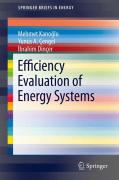
Efficiency evaluation of energy systems
Kanoglu, Mehmet
Cengel, Yunus A.
Dinçer, Ibrahim
Efficiency is one of the most frequently used terms in thermodynamics, and itindicates how well an energy conversion or process is accomplished. Efficiency is also one of the most frequently misused terms in thermodynamics and is often a source of misunderstanding. This is because efficiency is often used without being properly defined first. This book intends to provide a comprehensive evaluation of various efficiencies used for energy transfer and conversion systems including steady-flow energy devices (turbines, compressors, pumps, nozzles, heat exchangers, etc.), various power plants, cogeneration plants, and refrigeration systems. The book will cover first-law (energy based) and second-law (exergy based) efficiencies and provide a comprehensive understanding of their implications. It will help minimize the widespread misuse of efficienciesamong students and researchers in energy field by using an intuitive and unified approach for defining efficiencies. The book will be particularly useful for a clear understanding of second law (exergy) efficiencies for various systems. It may serve as a reference book to the researchers in energy field. The definitions and concepts developed in the book will be explained through illustrative examples. INDICE: Preface.- Chapter 1. Efficiency, Environment and Sustainability.- 1.1. Introduction.- 1.2. Energy, Exergy, Environment, and Sustainable Development.- 1.3. Efficiency and Energy Management .- Chapter 2. The First and the Second Laws of Thermodynamics.- 2.1. Introduction.- 2.2. Energy Change and Energy Transfer.- 2.3. The First Law of Thermodynamics.- 2.4. The Second Law of Thermodynamics.- 2.5. Entropy.- 2.6. Exergy.- Chapter 3. Energy and Exergy Efficiencies.- 3.1. Energy and Exergy Efficiencies.- 3.2. Efficiencies of Cyclic Devices.- 3.3. Efficiencies of Steady Flow Devices.- Chapter 4. Energy ConversionEfficiencies.- 4.1. Introduction.- 4.2. Conversion Efficiencies of Common Devices.- 4.3. Efficiencies of Mechanical and Electrical Devices.- 4.4. CryogenicTurbine Efficiencies.- Chapter 5. Efficiencies of Power Plants.- 5.1. Introduction.- 5.2. Efficiencies of Vapor Power Cycles.- 5.3. Efficiencies of Gas Power Cycles.- 5.4. Efficiencies of Cogeneration Plants.- 5.5. Efficiencies of Geothermal Power Plants.- 5.6. Energetic and Exergetic Analyses of a Photovoltaic System.- 5.7. Concluding Remarks.- Chapter 6. Efficiencies of Refrigeration Systems.- 6.1. Refrigerators and Heat Pumps.- 6.2. Second.Law Analysis of Vapor.Compression Refrigeration Cycle .- 6.3. Energy and Exergy Efficiencies of Vapor.Compression Heat Pump Cycle .- 6.4. Absorption Refrigeration Cycle.- 6.5. Liquefaction of Gases.- 6.6. Efficiency Analysis of Psychrometric Processes.- Nomenclature.- References.
- ISBN: 978-1-4614-2241-9
- Editorial: Springer
- Encuadernacion: Rústica
- Fecha Publicación: 30/04/2012
- Nº Volúmenes: 1
- Idioma: Inglés
